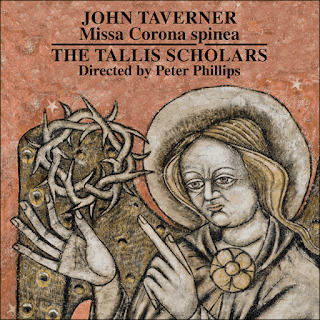John Taverner Missa Corona Spinea; The Tallis Scholars, Peter Phillips; Gimell Records
Reviewed by Robert Hugill on Oct 27 2015
Star rating:
Perhaps written to show off Cardinal Wolsey's own choir to Henry VIII, this mass provides an apt vehicle for the modern day Tallis Scholars
Having recorded John Taverner's virtuosic Missa Gloria Tibi Trinitas for their 40th anniversary (see my review), Peter Phillips and The Tallis Scholars have turned their attention to Taverner's Missa Corona Spinea for their latest disc on Gimell Records. One of the most astonishing works from the early Tudor period, Taverner's mass is paired with two versions of the Respond, Dum transisset Sabbatum.
Reviewed by Robert Hugill on Oct 27 2015
Star rating:
Perhaps written to show off Cardinal Wolsey's own choir to Henry VIII, this mass provides an apt vehicle for the modern day Tallis Scholars
Having recorded John Taverner's virtuosic Missa Gloria Tibi Trinitas for their 40th anniversary (see my review), Peter Phillips and The Tallis Scholars have turned their attention to Taverner's Missa Corona Spinea for their latest disc on Gimell Records. One of the most astonishing works from the early Tudor period, Taverner's mass is paired with two versions of the Respond, Dum transisset Sabbatum.
We do not know a great deal about Missa Corona Spinea. The chant on which it is based has not been identified so it is difficult to assign it to a particular occasion or a reason for the dedication to the crown of thorns (a feast in May which not of especial significance in the early Tudor period). But the music does tell us a lot. It is written for six-part choir but not the usual English layout of treble, mean, alto, alto, tenor bass. Instead it uses treble, mean, tenor, bass, bass, keeping the high treble part beloved of early Tudor composers. But in the case of Missa Corona Spinea, Taverner created a sort of virtuosic treble part which would only have been suitable for a few choirs. Very high and almost constantly present, the treble part contrasts with the more conventional five lower parts. In his notes on the work in the CD booklet Peter Phillips refers to it as a concerto for trebles.
John Taverner worked for Cardinal Wolsey at Cardinal College, Oxford where Wolsey created one of the finest choirs in England. Peter Phillips speculates that Taverner may have been commissioned to write the mass to show off the choir's trebles, and it is tempting to link it to a possible visit to the college by Henry VIII and Catherine of Aragon in 1527.
The work suits very much the style of The Tallis Scholars with the trebles, Janet Coxwell and Amy Haworth, presenting a fabulously even, fluid and unforced high treble line; a remarkable feat of virtuosity. You cannot imagine it being sung better than this. I have had discussions with other ensemble directors about the issue of what pitch music of this period should be performed at, whether we should perform it lower. But there is no doubt that this pitch suits The Tallis Scholars brilliantly.
Below the treble, the five other parts sing with their familiar sense of style and fluid line. The whole piece flows evenly and there are some remarkable passages, including ones where Taverner plays on the sheer distance between the top and bottom parts, but it is the trebles who catch our attention.
The companion works are Taverner's two version of Dum transisset Sabbatum the Respond to the third lesson at Matins on Easter Sunday. Both use the same chant in the tenor, but around this Taverner creates different harmonies and textures, each achieving the same sense of otherworldliness.
If you go to the Gimell website, then you can download the score to both the mass and to the motets, and the Cd booklet comes with an excellent essay as well as full texts.
John Taverner's virtuosic, festal masses are inevitably not to everyone's taste but here, with The Tallis Scholars on stunning form it is difficult to imagine an account more poised and more polished.
John Taverner (c1490-1545) - Miss Corona spinea [47.49]
John Taverner (c1490-1545) - Dum transisset Sabbbatum II [6.51]
John Taverner (c1490-1545) - Dum transisset Sabbbatum I [7.25]
The Tallis Scholars
Peter Phillips (conductor)
Recorded in the Chapel of Merton College, Oxford, 2015
GIMELL CDGIM046 1CD [62.07]
Elsewhere on this blog:
- In situ: Thomas Tudway's music for Wimpole Hall Chapel, recorded in the chapel - CD review
- The Telling and Niamh Cusack at BREMF: Vision: The Imagined Testimony of Hildegard von Bingen - concert review
- Musica Secreta at BREMF: Lucrezia Borgia's Daughter - concert review
- Poetry in music: The Sixteen & Harry Christophers - CD review
- Stockholm's Concert Hall is our home: My encounter with Stefan Forsberg of the Royal Stockholm Philharmonic Orchestra
- Time Machine: Roger Doyle, Answer-phone message and electro-acoustic music - CD review
- Violin showpieces transformed: Silver Bow from flautist Katherine Bryan
- Brave and bold: Tamsin Waley-Cohen & Huw Watkins in Hahn and Szymanowski - Cd review
- A shattering Butterfly in Stockholm: Asmik Grigorian in Kristen Harms' production at Royal Swedish Opera - opera review
- Not just another orchestra: Marios Papadopoulos and the Oxford Philharmonic Orchestra - interview
- Boulanger in Stockholm: Marc Soustrot and the Royal Stockholm Philharmonic in music by Lili and Nadia Boulanger - concert review
- In fine fettle, if lacking light and shade at first: Leo Nucci at Rosenblatt Recitals - concert review
- The Cello goes Latin American: Ophelie Gaillard Alvorada - CD review
- New music for woodwind: Twisted Skycape from Shea Lolin & Czech Philharmonic Wind Ensemble - CD review
- Intense & intellligent: Belcea Quartet in Mozart, Webern & Schubert - concert review
- Lithe and dramatic: ETO's Hollywood Hoffmann - Opera review
- Showcasing period flute and piano: Finchcocks Schubertiade - Cd review
- Home




%20Ali%20Wright.jpg)
.jpg)

%20Ali%20Wright.jpg)


%20and%20Hanna%20Hipp%20(Dinah)%20Credit_%20Genevieve%20Girling%20(4).jpg)

No comments:
Post a Comment